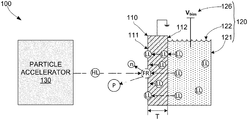Today I came across a recently published patent application from Google / University of California / University of British Columbia.
Looks like Google deserves a dedicated thread in the Players section therefore I created this one, since I could not find an existing thread.
It may be useful to publish all upcoming updates from Google (Team) in this thread.
Regarding the Google patent application:

Apparatus And Method For Sourcing Fusion Reaction Products
Abstract
An apparatus and method for sourcing nuclear fusion products uses an electrochemical loading process to load low-kinetic-energy (low-k) light element particles into a target electrode, which comprises a light-element-absorbing material (e.g., Palladium). An electrolyte solution containing the low-k light element particles is maintained in contact with a backside surface of the target electrode while a bias voltage is applied between the target electrode and an electrochemical anode, thereby causing low-k light element particles to diffuse from the backside surface to an opposing frontside surface of the target electrode. High-kinetic-energy (high-k) light element particles are directed against the frontside, thereby causing fusion reactions each time a high-k light element particle operably collides with a low-k light element particle disposed on the frontside surface. Fusion reaction rates are controlled by adjusting the bias voltage.
It's interesting to see they aim to combine electrolysis with high voltage plasma by having the cathode of the electrolysis serving as a separation membrane between the electrolysis compartment and the high voltage plasma compartment. From the application it is not clear whether they actually build this setup yet since no measurement data is provided.
To me this seems unnecessarily complicated.
Instead I would propose a high pressure gas compartment and a low pressure gas compartment with the cathode membrane acting as a seperator, with similar functions, leaving out the electrochemical part.
